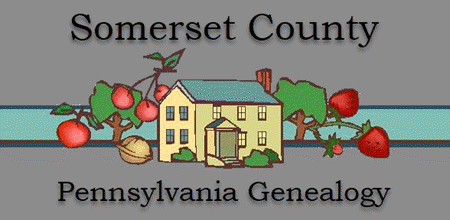|
Early History of Glade City School (Compiled by Fay Wentworth - Meyersdale Library. Copy printed to the Somgen email list by BMHuhn@aol.com.) The earliest records of Glade City School could not be found, but as early as 1889 Glade City was among the schools mentioned in the Somerset County Annual School Report. It appears to have been in existence prior to 1870. Shaped like an inverted L, there were two rooms in the building. The foot of the L made up the Big Room while the Little Room comprised the longer back of the letter. The Little Room, where the younger children were taught, was connected to the Big Room by an adjoining door making passage between the rooms easy, but there were two separate doors to the outside. Promotion to the Big Room meant you no longer used the front door, which opened at the back of the Little Room, but instead went to the side door that opened in the front of the Big Room. A bell that marked the passage of time hung over the Big Room. A rope came through the ceiling and privileged students were allowed to pull its length to ring the bell. It was rung to announce the beginning and the end of the school day and the two recesses and lunch period in between. There was a furnace in each room, and water was carried in a bucket from the Big Room to the Little Room. The two rooms shared common boys' and girls' bathrooms. OTHER EARLY SCHOOLS The first schools in Somerset County were subscription schools. They were taught in homes and deserted cabins. The patrons and teachers agreed upon the tuition of each child sent to school. Many of the names given to the schools came from the names of the families on whose farm the schools were built. Later the citizens erected schoolhouses of round logs, chucked with mortar and chips, with clapboard roofs. In some cases they had earth floors. In others the floors were made of split boards called puncheons. These boards were not nailed down, so if anything slipped through the cracks, a board could be lifted and the lost articles recovered. Later sawed boards were used and fastened down. The windows were openings in the wall, usually two or four to a room, with oiled paper over the openings before glass was installed. In the Meyersdale area a small schoolhouse was built in 1796 on the farm later owned by a Mr. Kensinger. There are no records of students meeting there. Also in 1796 a German school was taught by Mr. Geddinger in an old dwelling on the farm later owned by Mr. Harrick. The adoption of the Free School Act by the Pennsylvania legislature in 1844 which provided there be a certain number of Common Schools in each district met with resistance in Somerset County. Guns were loaded to shoot tax collectors who the 'Frosty Sons of Thunder' saw as men who would infringe on their liberties. Fortunately no blood was shed and by 1877 the people agreed to support the schools. Among the earlier classes taught in the one and two room schoolhouses were hygiene and physiology. According to the 1889 issue of the Common Schools of Somerset County, these courses met with resistance from the parents who thought they were not needed. Cleanliness was still next to Godliness but they felt it should not take up classroom time. Since corn was often turned into whiskey to make it easier to ship, many of the farmers resented the physiology class curriculum, which taught temperance. Later the parents were persuaded the classes were needed and even agreed to buy the books if funds were available. Summit Township, which at first included Meyersdale Borough, had been formed in 1842 from parts of Brothersvalley and Elk Lick Townships. As early as 1812 there was a schoolhouse in the borough of Meyersdale. In Summit Township there were fifteen schools, but by 1957 fourteen were closed, among them Glade City when Miss Sydney Lenhart decided to retire. Sandy Hollow closed the following year. EARLY GLADE CITY TEACHERS In 1898, with Emma Lenhart and H. H. Saylor teaching at Glade City, there were three reasons why a student could legally be excused from school; (1) such mental or physical conditions as renders attendance inexpedient or impracticable; (2) destitution of clothing and inability of parents to provide same; and (3) a distance of more than two miles to the school room. That year there were 51 enrolled in the primary section with an average of 33 attending. Miss Lenhart received $31.25/month. In the Big Room, Mr. Saylor received $33. The secondary level had 36 enrolled with an average of 19 attending each day. It is interesting to note that through the years many of the teachers had the same last name. Prior to 1887 the school term was 5 months. In 1887 it was increased to six and in 1899 to seven months. School began in September and ended in March. Once scholars completed their education at the two rooms they had the option of quitting school or going on to higher education in Meyersdale. In order to obtain a high school diploma at Meyersdale students had to complete courses in Algebra, Rhetoric, Natural Philosophy, Botany, Geometry, Latin, Physical Geography, General History, Civil Government, Literature, and German. Glade City school closed its' door in May 1957 and the property was later sold to Robert and Pauline Cook who built a home on the site. They still live there. Although the Cooks tore down the school building and built a new home, those who attended the school continue to refer to the site as Glade City School. |


![[PA] GenWeb](images/pamainlogo225_.jpg)